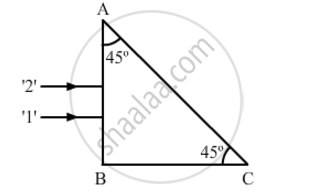Advertisements
Advertisements
Question
When monochromatic light is incident on a surface separating two media, why does the refracted light have the same frequency as that of the incident light?
Solution
The frequency and time period of an electromagnetic wave depends only on the source which produces it. The frequency is independent of the medium through which it travels. But the speed and wavelength depend on the medium through which the wave travels. Because of this, the frequency and time period of sound wave does not change due to change in medium.
RELATED QUESTIONS
When monochromatic light is incident on a surface separating two media, the reflected and refracted light both have the same frequency as the incident frequency.
'Two independent monochromatic sources of light cannot produce a sustained interference pattern'. Give reason.
Two monochromatic rays of light are incident normally on the face AB of an isosceles right-angled prism ABC. The refractive indices of the glass prism for the two rays '1' and '2' are respectively 1.3 and 1.5. Trace the path of these rays after entering the prism.

When light travels from a rarer to a denser medium, the speed decreases. Does this decrease in speed imply a reduction in the energy carried by the wave?
A monochromatic ray of light falls on a regular prism. What is the relation between the angle of incidence and angle of emergence in the case of minimum deviation?
Monochromatic light of frequency 5.0 × 1014 Hz is produced by a laser. The power emitted is 3.0 × 10–3 W. Estimate the number of photons emitted per second on an average by the source ?
If a monochromatic source of light is replaced by white light, what change would you observe in the diffraction pattern?
Find the angle of incidence at which a ray of monochromatic light should be incident on the first surface AB of a regular glass prism ABC so that the emergent ray grazes the adjacent surface AC. (Refractive Index of glass = 1 .56)
Using the monochromatic light of the wavelength in the experimental set-up of the diffraction pattern as well as in the interference pattern where the slit separation is 1 mm, 10 interference fringes are found to be within the central maximum of the diffraction pattern. Determine the width of the single slit, if the screen is kept at the same distance from the slit in the two cases.
For constructive interference to take place between two monochromatic light waves of wavelength λ, the path difference should be ______.
